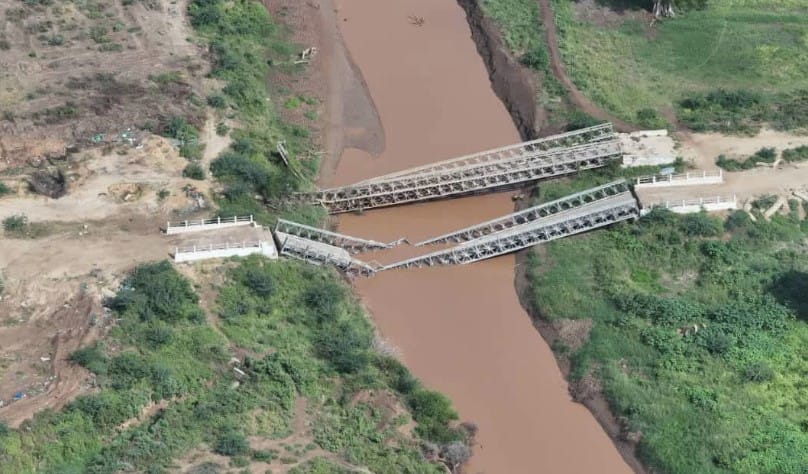Strategic Sabotage: Al-Shabaab's Bridge Destruction and Somalia's Security Crisis

In a significant escalation of insurgent tactics, Al-Shabaab militants destroyed the strategic Barire River bridge in Somalia's Lower Shabelle region on Monday, June 17, 2025, demonstrating the terrorist group's continued ability to disrupt military operations and undermine infrastructure development in the Horn of Africa[1]. This calculated act of sabotage occurred as Somali National Army (SNA) troops and African Union Support and Stabilization Mission in Somalia (AUSSOM) forces were attempting to reclaim key transportation routes that have been under militant control since early 2025[2]. The destruction of this critical infrastructure represents not merely a tactical setback but signals a broader pattern of Al-Shabaab's resurgence across central and southern Somalia, threatening years of fragile security gains[3].
The Strategic Significance of Somalia's Bridges
Critical Supply Routes and Military Mobility
The Barire River bridge, along with the Anole, Sabid, and Awdhegle bridges, constitutes a vital component of Somalia's limited transportation infrastructure, connecting the capital Mogadishu to key agricultural and commercial regions in the country's south[2:1][1:1]. These bridges serve as essential conduits for military supplies, humanitarian aid, and commercial goods, with their control directly impacting the government's ability to project power beyond urban centers[4]. The Lower Shabelle region, where these bridges are located, has historically functioned as a strategic corridor linking Mogadishu to the fertile agricultural areas that serve as Somalia's breadbasket[5].
For military operations, these bridges provide crucial crossing points over the Shabelle River, enabling rapid deployment of forces and logistical support to contested areas[6]. Their strategic value is heightened by Somalia's limited road network, with only 13 percent of the country's 21,830 kilometers of roads being paved, and most of those in poor condition[7]. This infrastructure deficit makes the few existing bridges disproportionately important for both military and civilian movement[8].
Economic and Humanitarian Impact
Beyond their military significance, these bridges play a critical role in Somalia's economic development and humanitarian response capabilities[9]. The destruction of the Barire bridge severs a key link in regional trade routes, disrupting agricultural supply chains and impeding access to markets for local farmers and merchants[10]. Similar infrastructure damage in the past has resulted in price increases for basic commodities in affected regions, exacerbating food insecurity in an already vulnerable population[4:1][5:1].
The bridge's destruction also complicates humanitarian access to communities in need, particularly as Somalia continues to grapple with the effects of climate-related disasters and displacement[11]. In previous instances of bridge destruction, such as the collapse of the Bardheere bridge in Jubaland State in 2023, humanitarian organizations faced significant challenges in delivering aid to affected populations, with some communities becoming completely isolated[11:1][10:1].
The June 17 Attack and Military Response
Tactical Details of the Bridge Destruction
Al-Shabaab militants detonated explosives on the Barire River bridge following intensified efforts by Somali and AUSSOM forces to reclaim key infrastructure seized by the group earlier in 2025[1:2]. The operation to destroy the bridge appears to have been well-planned, with militants anticipating the government offensive and preparing defensive measures, including deep trenches around other strategic bridges in the area[2:2]. This preparation suggests Al-Shabaab had advance intelligence about military movements and prioritized infrastructure sabotage as part of its defensive strategy[1:3][12].
The timing of the attack coincided with a broader military operation by government forces against Al-Shabaab strongholds in Sabiid, Caanoole, Aw-dheegle, and Barire over the preceding three days[1:4]. While these operations were initially kept secret to maintain the element of surprise, Al-Shabaab's preemptive sabotage indicates the group's effective intelligence gathering capabilities and operational flexibility[1:5][12:1].
Government and AUSSOM Counteroffensive
Somali government forces, with support from AUSSOM, have made attempts to retake the Anole and Sabid bridges, but these efforts have been thwarted by Al-Shabaab fighters who dug deep defensive trenches, forcing a temporary withdrawal of troops[2:3][1:6]. The third bridge in Awdhegle also remains under Al-Shabaab control, with no reported breakthroughs by government forces[2:4]. These setbacks highlight the challenges faced by conventional military forces when confronting an insurgent group employing asymmetric tactics in familiar terrain[12:2][3:1].
The Governor of Lower Shabelle, Ibrahim Aden Ali Najah, has remained in the area coordinating military strategy with Somali and AU commanders, underscoring the government's commitment to reclaiming these strategic assets despite the initial setbacks[1:7][6:1]. Mohamed Ibrahim Barre, the Minister of Constitutional Affairs for South West State and former Governor of Lower Shabelle, strongly condemned the demolition of the Barire Bridge, describing it as "a sign of their hostility toward the Somali people" and voicing support for ongoing joint military operations[1:8].
Al-Shabaab's Resurgence and Tactical Evolution
Territorial Gains in 2025
The destruction of the Barire bridge occurs within the context of Al-Shabaab's broader resurgence across central and southern Somalia in 2025[12:3]. Since February, the group has launched a significant counteroffensive, recapturing territory it had lost during government operations in 2022, particularly in the Middle Shabelle region[13]. By mid-May 2025, Al-Shabaab had managed to recapture most of the territory it lost in Middle Shabelle since 2022, including strategic towns such as Adan Yabaal, which had served as the group's regional center of operations before its capture by government forces in December 2022[13:1][3:2].
This offensive, dubbed the "2025 Shabelle offensive" or "Operation Ramadan," began on February 20, 2025, with coordinated attacks on multiple Somali military positions in the Middle Shabelle, Lower Shabelle, and Hiran regions[14]. The campaign represents Al-Shabaab's attempt to exploit security gaps created by the transition from the African Union Transition Mission in Somalia (ATMIS) to AUSSOM, as well as political divisions within the Somali government[14:1][3:3].
Infrastructure Targeting as Strategic Doctrine
The deliberate targeting of bridges and other critical infrastructure has emerged as a key component of Al-Shabaab's asymmetric warfare strategy[5:2][1:9]. By destroying bridges, the group achieves multiple tactical objectives: impeding military mobility, isolating communities from government control, disrupting economic activities, and demonstrating its operational reach despite international counterterrorism efforts[2:5][5:3].
This approach represents an evolution from Al-Shabaab's previous focus on direct attacks against security forces and government installations[5:4]. The group has increasingly recognized the strategic value of infrastructure sabotage as a means of undermining government legitimacy and control without directly engaging superior military forces[12:4][1:10]. Similar tactics have been observed in other conflict zones, where insurgent groups target infrastructure to maximize disruption while minimizing their own casualties[5:5][4:2].
Financing and Resource Mobilization
Al-Shabaab's ability to sustain its operations and territorial expansion is supported by a sophisticated revenue generation system that has evolved beyond traditional funding sources[15]. While the group has historically relied on checkpoint taxation and extortion at roadblocks, it has diversified its revenue streams to include property taxation, construction fees, and business "licensing" in areas far beyond its direct control, including in Mogadishu itself[15:1].
According to UN experts, Al-Shabaab requires approximately $1 million per month to pay salaries to its fighters, necessitating a constant flow of revenue[15:2]. The group has demonstrated remarkable adaptability in its financial operations, moving funds through local and Islamic banks despite government efforts to disrupt its financial networks[15:3]. This financial resilience enables Al-Shabaab to maintain operational capacity and recruit fighters even in the face of military pressure[15:4][3:4].
International Response and Counterterrorism Efforts
U.S. Military Operations in Somalia
The United States has significantly intensified its military operations in Somalia in 2025, with U.S. Africa Command (AFRICOM) conducting more than 25 airstrikes in the first five months of the year—double the number conducted during the same period in 2024[16]. This escalation reflects the Trump administration's more aggressive approach to counterterrorism in Somalia, giving commanders greater leeway to conduct attacks without first securing White House approval[16:1][17].
Most recently, on June 16, 2025, AFRICOM conducted an airstrike against Al-Shabaab near Bullo Xajji, a strategic village located approximately 80 kilometers west of Kismayo in southern Somalia[18][19]. While AFRICOM has withheld casualty figures citing operational security concerns, this strike represents the 40th U.S. bombing in Somalia this year according to official counts, putting the administration on track to break the previous record of 63 strikes set in 2019[20][18:1].
In addition to operations against Al-Shabaab, U.S. forces have also targeted ISIS-Somalia, particularly in the northeastern Puntland region[21]. On April 2, 2025, AFRICOM and the Federal Government of Somalia conducted a joint airstrike against ISIS militants southeast of Bosaso, supporting Puntland's Dervish Army efforts to eliminate the extremist group[21:1]. These parallel operations highlight the complex security landscape in Somalia, where multiple terrorist organizations operate simultaneously[21:2][17:1].
AUSSOM's Capabilities and Challenges
The African Union Support and Stabilization Mission in Somalia (AUSSOM), which replaced the African Union Transition Mission in Somalia (ATMIS) on January 1, 2025, faces significant challenges in supporting Somali security forces against a resurgent Al-Shabaab[22][23]. AUSSOM consists of approximately 11,900 personnel, including military, police, and civilian staff, contributed by Uganda, Ethiopia, Djibouti, Kenya, and Egypt[23:1]. This represents a reduction from previous AU missions, reflecting both financial constraints and the intended transition toward greater Somali security responsibility[23:2][22:1].
AUSSOM operates under a new Concept of Operations (CONOPS) adopted by the AU Peace and Security Council in August 2024, with a mandate to support Somalia's efforts in reducing the influence of Al-Shabaab while facilitating the transfer of security responsibilities to Somali forces[22:2][24]. The mission includes Quick Reaction Forces (QRFs), Tactical Battle Groups (TBGs), Intelligence, Surveillance and Reconnaissance (ISR) capabilities, and aviation enablers designed to enhance operational effectiveness against Al-Shabaab[24:1].
However, the transition from ATMIS to AUSSOM has created security gaps that Al-Shabaab has exploited, particularly as the new mission works to establish its operational footprint[14:2][3:5]. The reduced troop numbers and changing mandate have complicated efforts to maintain pressure on Al-Shabaab, especially in areas where Somali security forces lack the capacity to fill the void left by departing AU contingents[3:6][22:3].
Regional Security Implications
Threat to Mogadishu and Strategic Depth
Al-Shabaab's control of key bridges and territory in the Lower Shabelle region poses a direct threat to Mogadishu's security and the government's strategic depth[3:7][12:5]. The Lower Shabelle region serves as a buffer zone for the capital, with its proximity making it a potential staging ground for attacks on Mogadishu[5:6]. The capture of Hawadley, located just 39 miles north of Mogadishu, in early June 2025 further demonstrates Al-Shabaab's intent to encircle the capital and pressure the federal government[3:8][12:6].
The loss of control over critical infrastructure in this region compromises the government's ability to secure supply routes and maintain military pressure on Al-Shabaab strongholds[4:3][2:6]. This creates a dangerous dynamic where the group can consolidate control over rural areas while simultaneously threatening urban centers, including the capital itself[3:9][12:7]. Some analysts have raised concerns about the possibility of Al-Shabaab encircling or even overrunning Mogadishu, though others maintain that the group may lack the capacity or intent to seize the capital in the near term[3:10].
Broader African Security Context
The situation in Somalia must be understood within the broader context of terrorist threats across Africa, particularly in the Sahel region[25]. In late May 2025, U.S. Africa Command chief Gen. Michael Langley described the Sahel as "the epicenter of terrorism on the globe," warning that terror factions there are expanding rapidly and boosting their ability to carry out attacks on American soil[25:1]. According to Langley, groups like Jama'at Nasr al-Islam wal-Muslimin (JNIM) have quadrupled in size since 2022, while Al-Qaeda in the Lands of the Islamic Maghreb (AQIM) has tripled its presence in the same timeframe[25:2].
This regional security deterioration coincides with the withdrawal of U.S. and European forces from several countries in the Sahel, creating governance gaps that terrorist groups have exploited[25:3][16:2]. The situation in Somalia, with Al-Shabaab's resurgence despite years of international military engagement, exemplifies the challenges faced by counterterrorism operations across Africa and raises questions about the effectiveness of current approaches[25:4][3:11].
Conclusion: Prospects and Challenges
The destruction of the Barire River bridge represents more than a tactical setback for Somali and AUSSOM forces—it symbolizes the persistent challenges facing counterterrorism efforts in Somalia despite significant international investment[1:11][3:12]. Al-Shabaab's ability to target critical infrastructure, recapture lost territory, and sustain operations across central and southern Somalia demonstrates the group's resilience and adaptability in the face of military pressure[12:8][3:13].
Looking forward, several factors will shape the trajectory of the conflict:
- Political Cohesion: The effectiveness of counterterrorism operations depends significantly on political unity within Somalia's federal system[3:14]. Current political discord has hampered coordination between federal and state forces, creating opportunities for Al-Shabaab to exploit divisions[3:15][12:9].
- AUSSOM's Evolution: The new AU mission's ability to adapt its capabilities and approach to the changing security landscape will be crucial for maintaining pressure on Al-Shabaab while supporting the development of Somali security forces[22:4][23:3].
- Infrastructure Protection: Developing more effective strategies to protect critical infrastructure from sabotage will be essential for maintaining military mobility and economic development[8:1][10:2].
- Addressing Root Causes: Long-term success requires addressing the governance deficits, economic grievances, and clan dynamics that Al-Shabaab exploits to maintain support and recruitment[3:16][12:10].
The destruction of the Barire bridge serves as a stark reminder that military solutions alone are insufficient to address the complex security challenges in Somalia[3:17]. A comprehensive approach that combines targeted military operations with political reconciliation, economic development, and governance reforms offers the most promising path forward in countering Al-Shabaab's resurgence and building sustainable security in Somalia[3:18][12:11].
https://mustaqbalmedia.net/en/al-shabaab-destroys-barire-bridge-amid-renewed-military-offensive-in-lower-shabelle/ ↩︎ ↩︎ ↩︎ ↩︎ ↩︎ ↩︎ ↩︎ ↩︎ ↩︎ ↩︎ ↩︎ ↩︎
https://www.garoweonline.com/en/news/somalia/somalia-al-shabaab-blows-up-key-bridge-as-troops-advance-on-strategic-towns ↩︎ ↩︎ ↩︎ ↩︎ ↩︎ ↩︎ ↩︎
https://ctc.westpoint.edu/somalia-at-a-crossroads-resurgent-insurgents-fragmented-politics-and-the-uncertain-future-of-aussom/ ↩︎ ↩︎ ↩︎ ↩︎ ↩︎ ↩︎ ↩︎ ↩︎ ↩︎ ↩︎ ↩︎ ↩︎ ↩︎ ↩︎ ↩︎ ↩︎ ↩︎ ↩︎ ↩︎
https://riftvalley.net/wp-content/uploads/2023/10/Brokering-Trade-Routes_Final-Reduced.pdf ↩︎ ↩︎ ↩︎ ↩︎
https://www.intelligencefusion.co.uk/insights/resources/intelligence-reports/the-threat-of-al-shabaab-to-somalia-in-2019/ ↩︎ ↩︎ ↩︎ ↩︎ ↩︎ ↩︎ ↩︎
https://garoweonline.com/en/news/somalia/somalia-army-thwarts-al-shabaab-attack ↩︎ ↩︎
https://www.trade.gov/country-commercial-guides/somalia-economic-infrastructure-roads-airports-and-seaports ↩︎
https://mpwr.gov.so/wp-content/uploads/2019/03/SOMALI-NATIONAL-INFRASTRUCTURE-STRATEGY-SNIS.docx ↩︎ ↩︎
https://nec.gov.so/wp-content/uploads/2023/04/Trade-and-infrastructure-development-in-Somalia.pdf ↩︎ ↩︎ ↩︎
https://sonna.so/en/bardheere-bridge-collapses-after-heavy-rains/ ↩︎ ↩︎
https://warontherocks.com/2025/06/flailing-state-the-resurgence-of-al-shabaab-in-somalia/ ↩︎ ↩︎ ↩︎ ↩︎ ↩︎ ↩︎ ↩︎ ↩︎ ↩︎ ↩︎ ↩︎ ↩︎
https://ctc.westpoint.edu/wp-content/uploads/2025/05/CTC-SENTINEL-052025_cover-article.pdf ↩︎ ↩︎
https://en.wikipedia.org/wiki/2025_Shabelle_offensive ↩︎ ↩︎ ↩︎
https://www.voanews.com/a/somalia-s-al-shabab-militants-widening-revenue-base-/6827225.html ↩︎ ↩︎ ↩︎ ↩︎ ↩︎
https://www.airandspaceforces.com/us-has-doubled-its-airstrikes-in-somalia-surpassing-2024-levels/ ↩︎ ↩︎ ↩︎
https://defensescoop.com/2025/03/19/africom-airstrikes-drones-trump-administration-somalia/ ↩︎ ↩︎
https://www.ftlsomalia.com/us-airstrike-targets-al-shabaab-near-bullo-xajji/ ↩︎ ↩︎
https://ground.news/article/somalia-us-forces-conduct-strike-targeting-al-shabaab ↩︎
https://news.antiwar.com/2025/06/18/us-africa-command-launches-airstrike-in-somalia-targeting-al-shabaab/ ↩︎
https://sonna.so/en/somali-government-us-africa-command-conduct-joint-airstrike-against-isis-in-puntland/ ↩︎ ↩︎ ↩︎
https://www.radiodalsan.com/au-commits-to-enhancing-somalias-stability-in-2025/ ↩︎ ↩︎ ↩︎ ↩︎ ↩︎
https://en.wikipedia.org/wiki/African_Union_Support_and_Stabilization_Mission_in_Somalia ↩︎ ↩︎ ↩︎ ↩︎
https://nilepost.co.ug/news/250292/stakeholders-finalise-aussom-force-structure,-deployment-plans-in-mogadishu ↩︎ ↩︎
https://www.sofx.com/africom-commander-warns-of-growing-terror-threat-from-africas-sahel-region/ ↩︎ ↩︎ ↩︎ ↩︎ ↩︎




